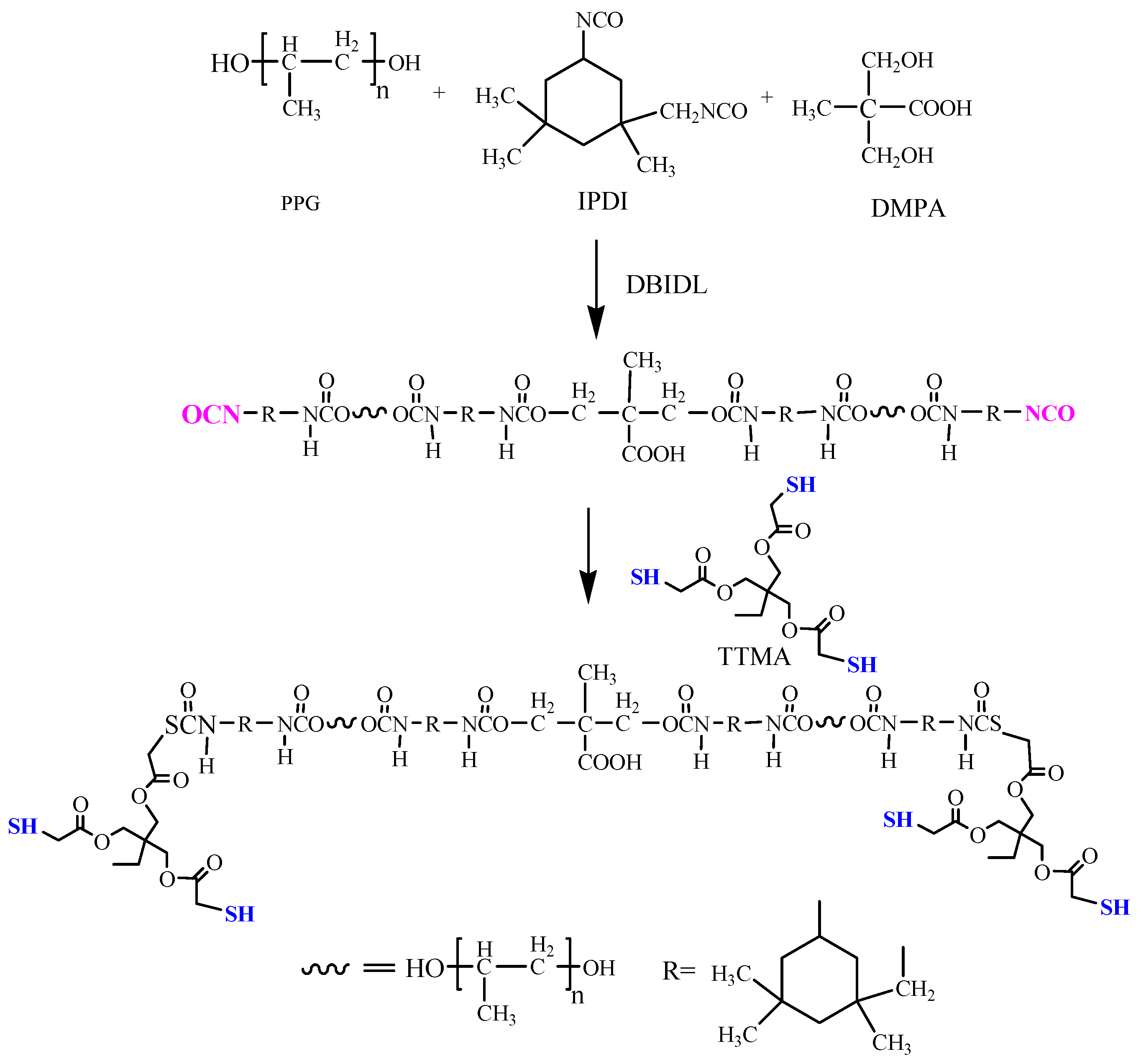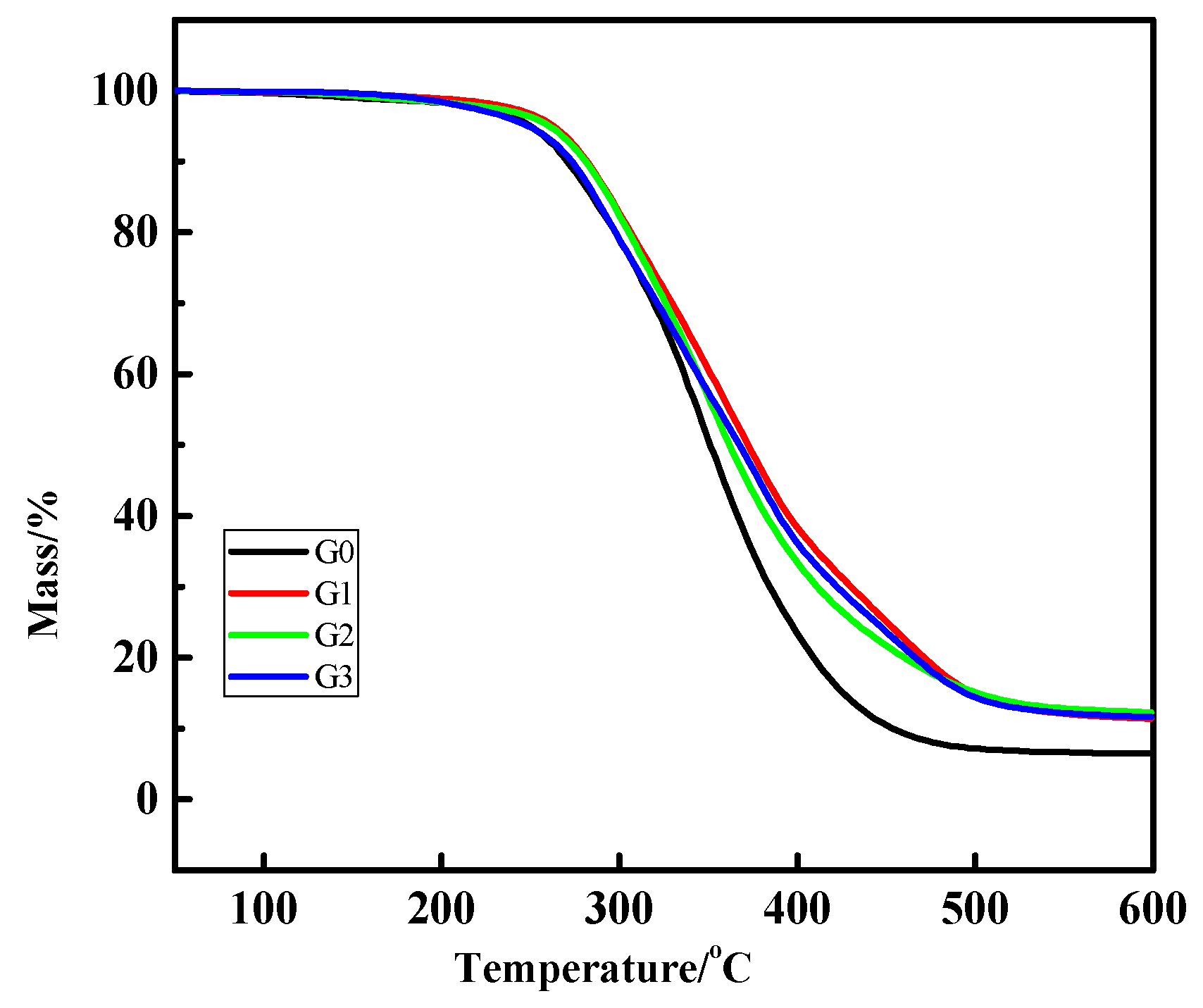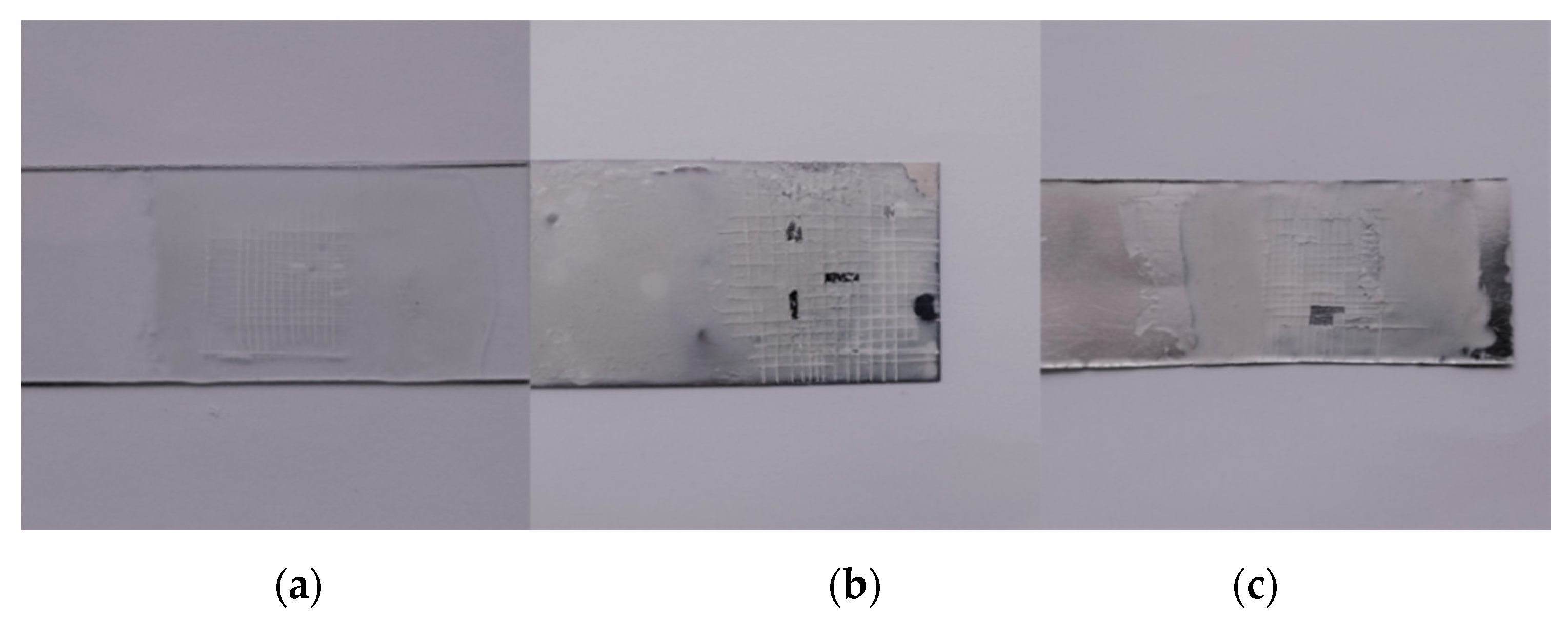UV-Cured Coatings Prepared with Sulfhydryl-Terminated Branched Polyurethane and Allyl-Terminated Hyperbranched Polycarbosilane
Abstract
:1. Introduction
2. Materials and Methods
2.1. Materials
2.2. Preparation of Sulfhydryl-Terminated Polyurethanes (Sulf-PUs)
2.3. Synthesis of Allyl-Terminated Hyperbranched Polycarbosilanes
2.4. Preparation of Ultraviolet (UV)-Cured Coatings
2.5. Characterization
3. Results and Discussion
3.1. The Influence of Curing Time
3.2. The Influence of Various Sulf-PUs
3.3. The Influence of Molar Ratio of 3-Mercaptopropyl to Allyl
3.4. The Influence of Generations of Allyl-Terminated Hyperbranched Polycarbosilanes
3.5. The Adhesive Properties
4. Conclusions
Supplementary Materials
Author Contributions
Funding
Conflicts of Interest
References
- Boton, L.; Puguan, J.M.; Latif, M.; Kim, H. Synthesis and properties of quick-drying UV-curable hyperbranched waterborne polyurethane coating. Prog. Org. Coat. 2018, 125, 201–206. [Google Scholar] [CrossRef]
- Wei, D.D.; Liao, B.; Yong, Q.W.; Li, T.; Wang, H.Y.; Huang, J.H.; Pang, H. Castor oil based hyperbranched urethane acrylates and their performance as UV-curable coatings. J. Macromol. Sci. Part A Pure Appl. Chem. 2018, 55, 422–432. [Google Scholar] [CrossRef]
- Cheng, C.; Zhang, X.; Huang, Q.; Dou, X.; Li, J.; Cao, X.; Tu, Y. Preparation of fully bio-based UV-cured non-is Cyanate polyurethanes from ricinoleic acid. J. Macromol. Sci. A 2015, 52, 485–491. [Google Scholar] [CrossRef]
- Ahmed, A.; Sarkar, P.; Ahmad, I.; Das, N.; Bhowmick, A.K. Influence of the nature of acrylates on the reactivity, structure, and properties of polyurethane acrylates. Ind. Eng. Chem. Res. 2015, 54, 47–54. [Google Scholar] [CrossRef]
- Wu, Y.F.; Liu, J.L.; Jiao, X.J.; Cheng, F.; Lai, G.Q.; Yang, X.F. UV cured transparent flexible silicone materials with high tensile strength. ACS Omega 2020, 5, 6199–6206. [Google Scholar] [CrossRef] [Green Version]
- Daniel, D.L.; Rubén, S.R.; Juan, C.G.Q.; Ignacio, M.G. Custom-made chemically modified graphene oxide to improve the anti-scratch resistance of urethane-acrylate transparent coatings. Coatings 2019, 9, 408. [Google Scholar]
- Kumar, R.; Yadav, R.; Kolhe, M.A.; Bhosale, R.S.; Narayan, R. 8-Hydroxypyrene- 1,3,6-trisulfonic acid trisodium salt (HPTS) based high fluorescent, pH stimuli waterborne polyurethane coatings. Polymer 2018, 136, 157–165. [Google Scholar] [CrossRef]
- Lorena, E.S.C.; Gilles, T.; Xavier, C.; Zeferino, G.A. Solvolysis of acrylate-urethane coatings cured by electron-beam and UV radiation. Prog. Org. Coat. 2019, 136, 105268. [Google Scholar]
- Mishra, A.K.; Narayan, R.; Aminabhavi, T.M.; Pradhan, S.K.; Raju, K.V.S.N. Hyperbranched polyurethane (HBPU)-urea and HBPU-imide coatings: Effect of chain extender and NCO/OH ratio on their properties. Prog. Org. Coat. 2012, 74, 134–141. [Google Scholar] [CrossRef]
- Bing, H.; Lin, Y. Highly heat-resistant silicon-containing polyurethane-imide copolymers: Synthesis and thermal mechanical stability. Eur. Polym. J. 2017, 91, 337–353. [Google Scholar]
- Pagacz, J.; Hebdab, E.; Janowskic, B.; Sternikd, D.; Janciab, M.; Pielichowskib, K. Thermal decomposition studies on polyurethane elastomers reinforced with polyhedral silsesquioxanes by evolved gas analysis. Polym. Degrad. Stabil. 2018, 149, 129–142. [Google Scholar] [CrossRef]
- Wei, D.D.; Huang, X.M.; Zeng, J.J.; Deng, S.L.; Xu, J.H. Facile synthesis of a castor oil-based hyperbranched acrylate oligomer and its application in UV-curable coatings. J. Appl. Polym. Sci. 2020, e49054. [Google Scholar] [CrossRef]
- Luke, A.B.; Lisa, M.R.; James, R.D.; Kathleen, S.C.; Pavel, N.; Michael, K.C.; Hilmar, K.; Matthew, J.D.; Matthew, B.D. Synthesis of a two-component carbosilane system for the advanced manufacturing of polymer-derived ceramics. Chem. Mater. 2018, 30, 7527–7534. [Google Scholar]
- Hiroshi, Y.; Yoshitada, S.; Tumula, V.R.; Yuko, U. Synthesis and electr Chemical, optical, and thermal properties of polycarbosilanes with silyleneevinyleneephenyleneevinylene backbones and triphenylamine or carbazole unit-containing side chains. J. Organomet. Chem. 2012, 710, 59–67. [Google Scholar]
- Liu, X.X.; Rathore, S.J.; Dubois, G.; Interrante, L.V. Grignard condensation routes to 1,3-disilacyclobutane-containing cyclolinear polycarbosilanes. J. Polym. Sci. Part A Polym. Chem. 2017, 55, 1547–1557. [Google Scholar] [CrossRef]
- Mirshahi, F.; Bastani, S.; Sari, M.G. Studying the effect of hyperbranched polymer modification on the kinetics of curing reactions and physical/mechanical properties of UV-curable coatings. Prog. Org. Coat. 2016, 90, 187–199. [Google Scholar] [CrossRef]
- Zhang, D.H.; Liu, C.H.; Chen, S.F.; Zhang, J.H.; Cheng, J.; Miao, M.H. Highly efficient preparation of hyperbranched epoxy resins by UV-initiated thiol-ene click reaction. Prog. Org. Coat. 2016, 101, 178–185. [Google Scholar] [CrossRef]
- Duan, Q.; Wang, S.Y.; Wang, Q.F.; Li, T.; Chen, S.F.; Miao, M.H.; Zhang, D.H. Simultaneous improvement on strength, modulus, and elongation nanotube films functionalized by hyperbranched polymers. ACS Appl. Mater. Interfaces 2019, 11, 36278–36285. [Google Scholar] [CrossRef]
- Cheng, J.; Wang, S.Q.; Zhang, J.H.; Miao, M.H.; Zhang, D.H. Influence of vinyl-terminated hyperbranched polyester on performance of films obtained by UV-initiated thiol–ene click reaction of A2+B3 system. J. Coat. Technol. Res. 2018, 15, 1049–1057. [Google Scholar] [CrossRef]
- Resetco, C.; Hendriks, B.; Badi, N.; Prez, F.D. Thiol-ene chemistry for polymer coatings and surface modification-building in sustainability and performance. Mater. Horiz. 2017, 4, 1041–1053. [Google Scholar] [CrossRef]
- Mishra, V.; Desai, J.; Patel, K.I. (UV/Oxidative) dual curing polyurethane dispersion from cardanol based polyol: Synthesis and characterization. Ind. Crop. Prod. 2018, 111, 165–178. [Google Scholar] [CrossRef]
- Wu, S.; Hayakawa, T.; Kikuchi, R.; Grunzinger, S.; Kakimoto, M. Synthesis and characterization of Semiaromatic polyimides containing POSS in Main chain derived from double-Decker-shaped Silsesquioxane. Macromolecules 2007, 40, 5698–5705. [Google Scholar] [CrossRef]
- Liang, S.Y.; Xu, K.; Liu, H.B.; Gui, X.F.; Zhang, T. Preparation and characterization of dimer fatty acid epoxy-acrylate resin hybrid emulsion for phot Curable coatings. Colloid Polym. Sci. 2019, 297, 1199–1211. [Google Scholar] [CrossRef]
- Fu, J.C.; Wang, L.; Yu, H.J.; Haroon, M.; Haq, F.; Shi, W.L.; Wu, B.; Wang, L.B. Research progress of UV-curable polyurethane acrylate-based hardening coatings. Prog. Org. Coat. 2019, 131, 82–99. [Google Scholar] [CrossRef]
- Flores, M.; Fernandez-Francos, X.; Ramis, X.; Sangermano, M.; Ferrando, F.; Serra, A. Phot Curing of cycloaliphatic epoxy formulations using polyesters with multiarm star topology as additives. J. Appl. Polym. Sci. 2014, 131, 596–602. [Google Scholar] [CrossRef]
- Dai, J.; Liu, X.; Ma, S.; Wang, J.; Shen, X.; You, S.; Zhu, J. Soybean oil-based UVcurable coatings strengthened by crosslink agent derived from itaconic acid together with 2-hydroxyethyl methacrylate phosphate. Prog. Org. Coat. 2016, 97, 210–215. [Google Scholar] [CrossRef]
- Miao, J.T.; Yuan, L.; Guan, Q.B.; Liang, G.Z.; Gu, A.J. Water-phase synthesis of a biobased allyl compound for building UV-curable flexible thiol-ene polymer networks with high mechanical strength and transparency. ACS Sustain. Chem. Eng. 2018, 6, 7902–7909. [Google Scholar] [CrossRef]





| Materials | Suppliers | Remarks |
|---|---|---|
| Polyether diol (PPG-2000, Mn = 2000, A.R.) | 9dingchem (Shanghai) Chemical Co., Ltd. | Distilled at 110 °C under 120°/130 mmHg for 1 h before used. |
| Isophorone diisocyanate (IPDI, A.R.) | ||
| 2,2-Bis(hydroxymethyl)propionic acid (DMPA, A.R.) | Energy Chemical (Shanghai) Chemical Co., Ltd. | / |
| Trimethylolpropane tris(thioglycolate) (TTMA, A.R.) | Tokyo Chemical Industry Co., Ltd. | / |
| Methyl trimethoxysilane (C.P.) | Shanghai Jiancheng Industry and Trade Co., Ltd. | / |
| Methyltrichlorosilane (C.P.) | / | |
| Ether (A.R.) | Beijing HWRK Chem Co., Ltd. | Distilled over potassium before used. |
| tetrahydrofuran (A.R.) | Distilled over potassium before used. | |
| HydroChloric acid (36.5%, A.R.) | Sinopharm Chemical Reagent Co., Ltd., China. | / |
| Ditin butyl dilaurate (DBTDL, A.R.) | ||
| sodium chloride (A.R.) | ||
| ammonium chloride (A.R.) | ||
| magnesium sulfate anhydrous (A.R.) | ||
| toluene (A.R.) | ||
| Magnesium powder (A.R.) | Shanghai Lingfeng Chemical Reagent Co., Ltd. | / |
| 3-Bromopropene (A.R.) | Adamas Reagent Co., Ltd. (Shanghai) | / |
| iodine (A.R.) | TCI (Shanghai) Chemical Industrial Development Co., Ltd. | / |
| Platinum catalyst | Prepared by our group | The content of Pt is 8000 ppm |
| Sulf-PU | The Molar Ratio of NCO to OH | The Amount of the Raw Materials/mol | |||
|---|---|---|---|---|---|
| IPDI | DMPA | PPG-2000 | TTMA | ||
| Sulf-PU-1 | 2:1 | 0.04 | 0.01 | 0.01 | 0.04 |
| Sulf-PU-2 | 3:1 | 0.06 | 0.01 | 0.01 | 0.08 |
| Sulf-PU-3 | 4:1 | 0.08 | 0.01 | 0.01 | 0.12 |
| Sulf-PU-4 | 5:1 | 0.1 | 0.01 | 0.01 | 0.16 |
| Sulf-PU-5 | 6:1 | 0.12 | 0.01 | 0.01 | 0.20 |
| Sulf-PU-6 | 7:1 | 0.14 | 0.01 | 0.01 | 0.24 |
| Entry | Curing Time/s | Degree of Curing Content /% | Pencil Hardness | Surface Water Contact Angle/° | Water Absorption/(wt%) |
|---|---|---|---|---|---|
| 1 | 10 | 63.0 | 5B | 89.6 | 1.36 |
| 2 | 20 | 72.8 | 2B | 93.2 | 1.06 |
| 3 | 30 | 82.0 | B | 95.8 | 0.75 |
| 4 | 40 | 85.6 | HB | 102.2 | 0.60 |
| 5 | 50 | 85.8 | HB | 102.1 | 0.62 |
| 6 | 60 | 86.2 | HB | 102.8 | 0.59 |
| Entry | Sulf-PU | The Pencil Hardness | The Surface Water Contact Angle/° | Water Absorption/(wt%) |
|---|---|---|---|---|
| 1 | Sulf-PU-1 | 5B | 88.5° | 1.06 |
| 2 | Sulf-PU-2 | 3B | 93.4 | 0.95 |
| 3 | Sulf-PU-3 | 3B | 95.1 | 0.97 |
| 4 | Sulf-PU-4 | HB | 102.2 | 0.60 |
| 5 | Sulf-PU-5 | 2B | 96.4 | 0.70 |
| 6 | Sulf-PU-6 | 2B | 96.8 | 0.73 |
| Entry | Molar ratio of 3-Mercaptopropyl to Allyl | Pencil Hardness | Surface Water Contact Angle/° | Water Absorption/(wt%) |
|---|---|---|---|---|
| 1 | 0.8 | 4B | 85.5 | 1.03 |
| 2 | 1.0 | 3B | 91.4 | 0.87 |
| 3 | 1.2 | B | 96.8 | 0.64 |
| 4 | 1.4 | HB | 102.2 | 0.60 |
| 5 | 1.6 | 2B | 87.1 | 0.75 |
| 6 | 1.8 | 3B | 72.1 | 0.82 |
| Entry | Generations of Allyl-Terminated Hyperbranched Polycarbosilanes | Pencil Hardness | Surface Water Contact Angle/° | Water Absorpti on/(wt%) |
|---|---|---|---|---|
| 1 | G0 | 5B | 75.8 | 1.07 |
| 2 | G1 | 3B | 87.9 | 0.64 |
| 3 | G2 | HB | 102.2 | 0.60 |
| 4 | G3 | B | 98.2 | 0.63 |
| Substrates | Glass Slide | Tin plate | Aluminum Sheet |
|---|---|---|---|
| Adhesive grade | Grade 1 | Grade 2 | Grade 3 |
© 2020 by the authors. Licensee MDPI, Basel, Switzerland. This article is an open access article distributed under the terms and conditions of the Creative Commons Attribution (CC BY) license (http://creativecommons.org/licenses/by/4.0/).
Share and Cite
Jiao, X.; Zhang, T.; Cheng, F.; Fan, Y.; Liu, J.; Lai, G.; Wu, Y.; Yang, X. UV-Cured Coatings Prepared with Sulfhydryl-Terminated Branched Polyurethane and Allyl-Terminated Hyperbranched Polycarbosilane. Coatings 2020, 10, 350. https://doi.org/10.3390/coatings10040350
Jiao X, Zhang T, Cheng F, Fan Y, Liu J, Lai G, Wu Y, Yang X. UV-Cured Coatings Prepared with Sulfhydryl-Terminated Branched Polyurethane and Allyl-Terminated Hyperbranched Polycarbosilane. Coatings. 2020; 10(4):350. https://doi.org/10.3390/coatings10040350
Chicago/Turabian StyleJiao, Xiaojiao, Taixu Zhang, Fei Cheng, Yunxin Fan, Jiangling Liu, Guoqiao Lai, Yufei Wu, and Xiongfa Yang. 2020. "UV-Cured Coatings Prepared with Sulfhydryl-Terminated Branched Polyurethane and Allyl-Terminated Hyperbranched Polycarbosilane" Coatings 10, no. 4: 350. https://doi.org/10.3390/coatings10040350






